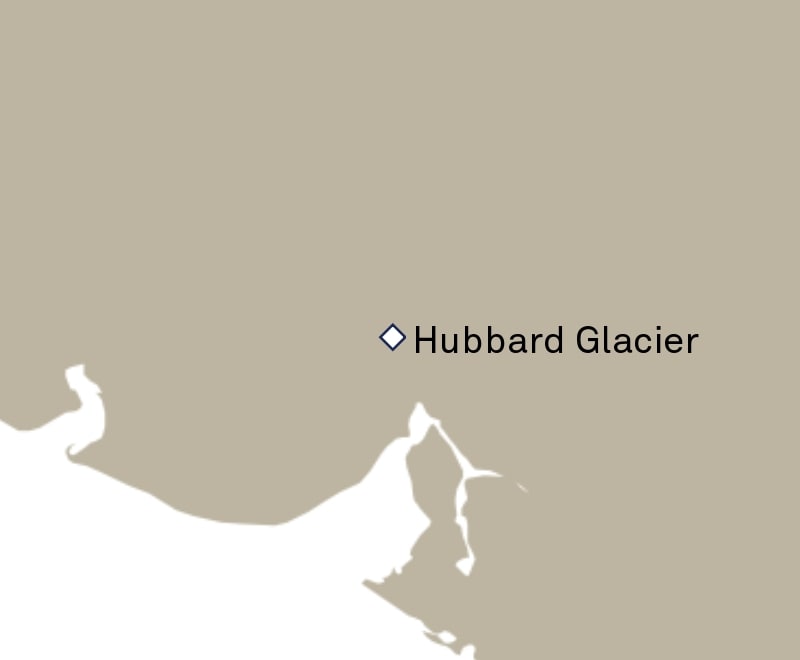Hubbard Glacier, Alaska, USA (Scenic Cruising) cruises

Hubbard Glacier Port Guide.
The largest tidal glacier in North America, Hubbard Glacier is a rarity; an icy abyss, formed over centuries, where nature, not man, is King. Only by cruising alongside it can you appreciate the majesty of its colossal scale. It’s a sight quite unlike anything else, drawing the curiosity of visitors keen to experience one of the natural world’s most humbling creations.
Top landmarks and sights in Hubbard Glacier.
The top landmark to see in Hubbard Glacier is of course Hubbard Glacier itself. This phenomenal natural wonder is a sight to behold; a gargantuan glacier of ice, 76 miles long and over 2000 feet deep in parts.
It is the largest tidewater glacier in North America and yet just 350 feet of its mass is visible above water. The bulk remains hidden beneath the surface, faced with a 400-year wait to breach the tideline; the exact length of time it takes for the ice to traverse the glacier’s body and meet air for the first time.
Witness the grace and brilliance of glacial formations and towering icebergs in action as you sail by a highlight of Alaska’s many coastal wonders. Learn the history it’s created and take in the view. Hubbard Glacier has dictated local geography and human endeavour over millennia. This is your chance to get close to one of Earth’s majestic giants of slow-moving ice.
Things to do in Hubbard Glacier.
A cruise-by of Hubbard Glacier offers the perfect opportunity to slow down, forget the outside world, and immerse yourself in the beauty of Alaska’s unspoiled scenery.
There is no civilisation here. No roads to travel on or telephone masts to connect to. No enduring evidence of man’s existence whatsoever. The only way to see Hubbard Glacier is by ship and even then only a handful of vessels are permitted access each year. Many who venture here have never seen a glacier. Those that fail to visit most likely never will. Yet to be among the few to have experienced Hubbard Glacier affords you more than bragging rights.
It is disarmingly beautiful. Emitting a curious iridescent glow that even the sharpest lens fails to capture while casting out icebergs the size of buildings. The occasional echo of cracking ice is the only discernible sound in the otherwise pin-drop silence. A tell-tale sign of life in this gentle sleeping beast.
Grab your binoculars and search for sea lions lazing on the glacier’s surface, or keep a watchful eye for an orca fin rising from the mysterious depths. Order breakfast in your stateroom and enjoy the frontline views of Hubbard Glacier from the privacy of your balcony. Or set your alarm for just before sunrise, taking advantage of your ship’s secluded deck as the first signs of daylight illuminate the glacier in all its glory.
Hubbard Glacier culture and history.
Hubbard Glacier is named after Gardiner Hubbard, the first President of The National Geographical Society, a tribute awarded in 1890. It straddles the US and Canadian borders in Southeast Alaska and is one of the few glaciers advancing rather than retreating, gaining an average of 80 feet each year at its current rate of growth.
While all glaciers retreat and expand in response to climate conditions, Hubbard Glacier’s rate of advancement is exceptional by contrast, not least because it advances during warmer climates, when glaciers typically retreat.
Its unique glacial cycle is prompted by excess precipitation cooling when it meets the St. Elias Mountains, turning the moisture into snow which subsequently feeds the glacier. Such is its force, that in 1986 and 2002, Hubbard Glacier blocked the entrance to Russell Fiord for several weeks, until ice calving reopened the channel.
While the advancement is so slow it’s impossible to see with the naked eye, you may yet witness a piece of the glacier breaking off to form a new iceberg; a magical reminder that this feat of nature is still very much a work in progress.